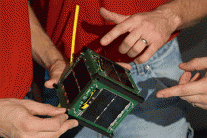The University of Louisiana at Lafayette has taken its place in the top level of the nation’s research institutions
CAPE-2 satellite to hitch ride on NASA rocket
Tue, 11/19/2013 - 3:42pmUniversity students will team with NASA to launch their CAPE-2 satellite.
The small, solar-powered satellite will be sent into orbit on a Minotaur 1 rocket during a NASA launch scheduled 6:30 p.m. on Tuesday, Nov. 19 from NASA’s Wallops Island, Va. facility.
Students, who designed and built the CubeSat as part of the Cajun Advanced Pico-satellite Experiment-2, will man ground station equipment in the CAPE Lab on campus. The lab is located in Madison Hall, Room 146.
If all goes according to plan, the satellite will travel 225 miles above the surface of the Earth at about 17,000 miles per hour. It will circle the globe once about every 90 minutes.
The satellite, which is about 10 centimeters by 10 centimeters and weighs about 2 pounds, will serve as a communication device once in orbit. Students will maintain contact via radio signals, audio recordings and tweets.
CAPE-2 is one of 29 satellites created by educational and research facilities from across the nation chosen to participate in NASA’s CubeSat Launch Initiative.
In addition to UL Lafayette, 14 other schools are participating in the project, including Drexel University and the University of Florida.
About 50 University students have taken part in the CAPE-2 project, which began about seven years ago, including mechanical engineering, electrical engineering and computer science majors.
A core team of about 10 students completed the satellite during the last six months of the project.
The team in mentored by Nick Pugh, a communication industry professional and University alumnus who earned a bachelor’s degree in electrical engineering in 1968.
Pugh, who spends as much as 20 hours per week with the team, offers technical advice and encouragement.
“Their professors teach them, and I help them apply what they’ve learned,” said Pugh, who is also a financial supporter.
This is the second CubeSat created at UL Lafayette. In 2007, the University became the first in Louisiana whose students designed, built and launched a working satellite, CAPE-1. The satellite still orbits Earth, although it no longer transmits signals.

